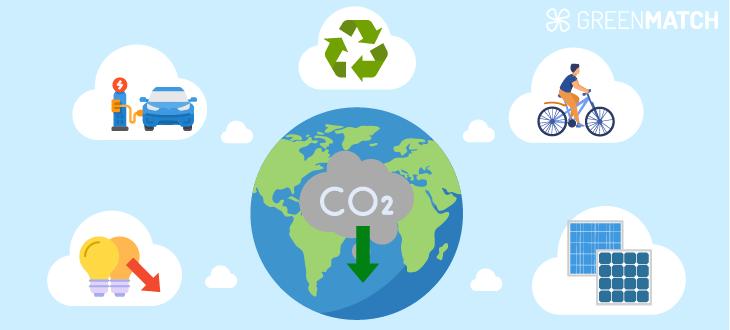- GreenMatch
- Ways To Reduce Your Carbon Footprint
Ways To Reduce Your Carbon Footprint


In recent years, the importance of protecting our planet has become an increasingly common topic. Notably, we must try to reduce our high greenhouse gas emissions, which drive global warming and climate change.
Carbon dioxide accounts for approximately 76% of all manmade greenhouse gases, making it one of our most intense emissions. This also means it’s the one we must closely monitor and try to reduce.
So how can we do this? How can we reduce our carbon footprint and help limit the damage this gas can cause to our environment, health, surrounding biodiversity and ecosystems?
For this article, we’ve asked experts from various backgrounds to gain tips and insights to help us take action in all areas of our lives. We’ve spoken to energy advisors, home improvement experts, engineers, emissions advisors and renewable energy providers to give you the best and fullest set of tips, which you can use to transform your carbon footprint completely.
What is a carbon footprint?
Any person or business can have a carbon footprint. This is a calculated total of how much carbon you emit in your daily activities. This can include, for example, how you choose to travel, which foods you eat and how you use energy throughout your home. Each aspect of your routine can directly or indirectly contribute to your carbon emission footprint.
Direct emissions would come from burning fossil fuels, such as driving a petrol car or switching on a gas boiler. Indirect emissions can be those you contribute through your choices. For example, if you purchase single-use plastic (produced from fossil fuels), you are driving further production and emission levels.
In 2022, global emissions reached their highest recorded levels. This is due to fossil fuels like coal, gas and oil, combined with major industrialisation and population increases. Countries such as China and America now have the highest carbon footprint in the world.
Understanding your carbon footprint and its impact is the first step towards making a difference. There are key areas you can look at to identify things you could change. This includes your home energy use and waste production, how you travel, the food you eat, and how you shop. You can find helpful carbon footprint calculators online to give you a good idea of where to begin. Every action, no matter how small, adds up. We can collectively work towards a more environmentally friendly and sustainable future by adopting sustainable practices.
Reduce your carbon footprint at home
Around 22% of the UK’s carbon emissions come from our homes. This is because of how we heat our homes and power our lighting and appliances.
The energy and fuel we use to keep our homes safe and comfortable can all add up, particularly if we’re not practising recycling or other waste management. Reducing our consumption of these energy sources can make a huge difference.
Below are the best practical tips that can help you reduce energy use and improve carbon emissions around the home.
1. Switch to renewable energy sources

As far as carbon-reducing tips go, this is the biggie! Switching to a renewable energy source can mean that everything you power in your home has a completely green energy source - and produces zero emissions!
Renewable energy sources include air-source heat pumps, solar panels or wind turbines. These can all be installed for your home to produce electricity or for heating and cooling, so you can drastically reduce your dependence on fossil fuels.
Many of the experts we spoke to agree that this was one of the best ways to reduce your carbon footprint. For example, installing home solar panels could save up to 1 tonne of carbon per year.
Environmental expert Mike Millerson explains:
Renewable energy undoubtedly plays a crucial role in reducing carbon footprints. Energy sources such as wind, solar, and hydroelectric power do not produce carbon dioxide during operation, thus reducing the overall carbon emissions.
Solar power
Installing solar panels is one of the most popular choices for homeowners looking to reduce their emissions drastically. These systems come with many benefits, as this solar expert told us:
Transitioning away from fossil fuels to solar energy is like trading in a gas-guzzler for a sleek, efficient electric car. The impact on carbon emissions is profound. Solar power is clean and renewable, meaning we can generate electricity without the harmful emissions associated with fossil fuels. It’s a crucial step towards a more sustainable, cleaner future.
Solar is fast becoming a key tool in our fight against climate change. An environmental blogger we spoke with summed up the promising outlook of this renewable technology:
Investing in renewable energy promotes sustainability, decreases dependency on finite resources, and mitigates the environmental impact associated with fossil fuel extraction and combustion. Ongoing advancements in renewable technologies continue to enhance efficiency and lower costs, making these sources more accessible and viable for widespread adoption.
Solar panels can be quite an expensive investment, typically costing around £7,000, depending on the size of your home. This might seem like a lot, but your savings each year can give you a return on your investment. You will no longer be tied to an energy supplier and their fluctuating bills.
Green energy suppliers
If you cannot switch to a renewable energy system, another option might be to choose an energy provider offering a renewable energy plan. Many UK suppliers are now producing energy through solar and wind farms. By choosing one of these suppliers, you reduce your carbon footprint and contribute to wider efforts nationally to produce green energy.
2. Update your heating system
We know that to reduce our carbon footprint, we need to manage how much we depend on burning fossil fuels for energy. This is particularly important when it comes to the way we heat our homes.
Around 14% of all carbon emissions in the UK are directly linked to using gas boilers. This is because most of the country runs old, inefficient boilers with lower performance and higher emissions. Luckily, there are steps we can take to reverse this.

Replace an old boiler
Modern boilers can offer efficiency levels of over 92% (depending on the make and model) and also use condensing technology. This means less fuel is wasted, and more energy is converted into heat.
If your boiler is over 10-15 years old, it could be time for a replacement. As boilers age, they lose efficiency, and many current boilers are not made with the same energy-saving technology as they are today.
Choose renewable fuel options
You could opt for a renewable, low-carbon heating system such as an air source or ground source heat pump. These are highly efficient systems that cost very little to run, however they can be more expensive to install - air source heat pump prices can be between £1,500 to £45,000 depending on the type and size you need.
Alternatively, you can upgrade an old boiler for a new efficient model. You may also consider switching to a boiler fuelled by electricity instead of oil or gas. Electric boilers are the most energy-efficient option, and if they can be paired with a renewable energy source (such as solar power), they become emissions-free.
Update your heating controls

Taking more control of how and when you use your heating can be a good way to keep track of your emissions. Smart thermostats and other wireless control devices can help you better control your system's operation.
This can include setting smart timers, heating individual rooms at set times, or even turning your heating on or off when you’re away from home. You can also use thermostatic radiator valves to set different room temperatures.
We can often run heating in rooms we’re not using simply because we forget the radiator is on. We might even leave the house and forget to turn the system off! This can lead to a huge amount of fuel being wasted, as well as expensive bills. With a smart thermostat or effect timer, this can be avoided.
3. Insulating your home
Another key aspect of keeping your home warm without wasting energy is ensuring it is properly insulated. If your walls, windows and doors are not well sealed or insulated, it can lead to large amounts of heat escaping.
We know that creating heat leads to carbon emissions, so if our boilers work twice as hard to keep our homes warm, this only leads to more harmful gas entering the atmosphere. Our experts suggest simple insulating measures to combat this, as detailed below.
Cavity wall, loft and floor insulation

Depending on when your house was built, you may or may not have insulation installed. Homes built after the 1990s tend to have wall insulation; however, earlier buildings could have walls with cavities (where a gap exists between the outer brick and inner wall).
Uninsulated walls can result in up to a third of the heat in your home escaping. That will cost you more in energy bills to keep any room at a constant temperature, plus it means further fuel burning and carbon emissions.
The same is true of loft insulation, which can prevent the loss of a quarter of your home's heat! Both insulation measures will need professional installation, which involves injecting insulation into wall cavities or laying mineral wool insulation layers in your loft.
You may also want to consider floor insulation if you live on a ground floor or above a space (such as a garage).
Costs for each type of insulation will differ depending on the installers, location, and size of your home. There are significant savings to be made, which can see the return on your investment in as few as 5 years in the case of wall insulation.
Below is a table showing the most recent cost estimates and an indication of the amount of carbon which can be saved with each insulation measure.
| Insulation Type | Installation Cost | Annual Savings | Carbon Dioxide Savings (Kg CO2/year) |
|---|---|---|---|
| Cavity Wall | £1,000 - £4,600 | £125 - £455 | 305kg - 1100kg |
| Roof/Loft | £880 - £1,200 | £225 - £41 | 550kg - 1000kg |
| Floor | From £4,700 | £50 - £135 | 125kg - 330kg |
gas-heated homes. Costs will vary depending on the work level needed. Figures are based on fuel prices as of October 2023. Sourced via Energy Saving Trust.
Insulate radiators and hot water cyclinders
You can also benefit by insulating any radiators or your hot water cylinder if you have one. This can help them to retain more heat, keeping your hot water and your home warmer for longer.
A hot water cylinder insulating cover (or ‘jacket) costs around £20 and is straightforward to fit. Radiator reflector panels sit behind your radiator to reflect heat into the room and are particularly good options for those with uninsulated walls. These cost between £10 - £25 depending on the size and quantity you need.
Both options can help save you additional energy and lower your bills. For example, installing an 80mm thick cylinder cover could save you up to £45 per year.
Seal up draughts and gaps
Draught-proofing your home is an extra way to save on energy and avoid excess fuel consumption. Sealing gaps around your doors and windows will stop heat escaping and cold air seeping in. Many products are available to help prevent you from losing heat, such as weather stripping for windows (which helps close up any gaps around the seal) or draught excluders for doors.
You could save around £45 a year by using some of these measures, as your home will be more comfortable and retain heat better, meaning you can turn down the heating.
4. Use energy-efficient products

Appliances and products which use electricity can differ in their efficiency levels. One good way to check if your appliances perform well is to check their ErP rating (Energy-related Performance) - the standard currently used in the UK to measure how efficient an appliance is at the point of sale.
Big home appliances, such as boilers, washing machines, and dishwashers, can consume huge amounts of energy. It’s important that when shopping for new products, you check for an ErP rating. This will reveal how well the product uses energy on a scale from A to G. Those with A ratings will release the fewest emissions, so this is always a good standard.
There are some other tips which our experts have shared for you to get the most from your energy use.
Low energy lighting
Several contributors told us that lighting throughout our home is one area most of us can improve fairly quickly.
Modern LED bulbs are known as ‘low energy’ lighting, using up to 90% less electricity than conventional bulbs. By replacing your bulbs with LED ones, you can reduce your carbon footprint by up to 65kg a year (equal to driving over 200 miles in a car).
Use electricity at the ‘right’ time
Not everyone may realise, but at certain times of the day, our electricity supply is considered ‘cleaner’ than at other times. According to The National Grid:
This is all down to carbon intensity – a measure of how much carbon dioxide (CO2) emissions are produced per kilowatt hour of electricity consumed. The lower the carbon intensity figure, the cleaner the electricity is. And when the carbon intensity is very low, it suggests that renewable or nuclear energy is playing a bigger part in the electricity flowing into your home.
Accessing energy during low-carbon periods will directly reduce your carbon footprint and positively impact the environment. National Grid predicts that if one million people in the UK used their washing machines during these times, we could save the equivalent carbon output of taking 78,214 cars off the road.
There are apps and voice assistants available to determine when the carbon intensity is at its lowest in your area. Search for ‘WhenToPlugIn’ to make use of this handy tool.
5. Reduce. Reuse. Recycle

You may encounter this phrase several times when considering reducing your carbon footprint. The concept behind it is simple - we must find ways to reduce our waste, reuse as much as possible and recycle those items we can’t repurpose.
This point covers everyday items from packaging, clothes, electronics and most importantly, plastics. The huge quantities of waste that we produce globally have led to overflowing landfills that are damaging the environment and polluting ecosystems. We can help cut emissions and protect the environment by adopting the reduce, reuse, and recycle philosophy.
Reduce and Reuse
Reducing the amount we buy, whether brand new or the amount we throw away, are both key parts of this concept. Cutting down on the amount we buy can help reduce the need for new products - such as plastics, clothing, and packaging.
We can find alternative ways to reuse items so that we buy and throw away less. Plastic materials are created directly from fossil fuels, and by supporting single-use plastics, we’re fuelling the production cycle and adding emissions to the air.
Global plastic pollution is widely mismanaged, with millions of tonnes of it ending up in the oceans or landfills. It is estimated that plastics generated 1.8 billion tonnes of greenhouse gas emissions in 2019 (expected to double by 2060), and 90% of these emissions come directly from the production stage.
You can practice reducing, reusing and recycling by adopting a zero-waste lifestyle. This involves small changes that reduce your carbon footprint and contribute to the environment.
Recycle
Most of the experts we spoke with highlighted the importance of recycling to reduce your carbon footprint. This is because sending waste to landfills can increase emissions, so where possible, we should always try to recycle as much as we can.
Seth Beard is a director for the plastics action platform Ocean Works. They help find alternatives to plastic and fund plastic waste removal. In line with this, Seth told us how important it is to prioritise recycling:
Recycling helps reduce greenhouse gas emissions by reducing energy consumption. Using recycled materials to make new products reduces the need for virgin materials. This avoids greenhouse gas emissions from extracting or mining virgin materials.
Every time we throw away plastic or buy new single-use items, we make new plastic that emits harmful gases into our atmosphere. By recycling, we allow production to come from an existing source through chemical recycling, dramatically reducing the need to use fossil fuels.
Compost
Another way to encompass the philosophy of reuse and recycling is to compost food waste. This is a great way to avoid contributing to landfills, and it can be done at home, in schools or even at work. The compost you produce can even help support local gardens or community projects.
6. Rethink your food choices
In recent years, we’ve seen more people adopting diets prioritising ethical causes. Whether you opt to go vegan or want to reduce your environmental impact, there are some ways the food you choose can help.
Plant based diet

Recent studies from the University of Oxford found that going vegan could reduce an individual’s carbon footprint by up to 73%. This is because the meat and dairy industry are responsible for high percentages of global greenhouse gas emissions.
Livestock farming in the UK is responsible for 47% of the country's methane emissions, a significant greenhouse gas contributing to global warming. In addition, agriculture requires large equipment, heavy land use, high water consumption and ongoing transportation of goods.
Reports indicate that agriculture is the fifth-highest contributing sector for greenhouse gases. In contrast, however, the production of fruits and vegetables does not require the same level of energy use, which reduces greenhouse gas emissions.
Choose locally sourced
Whichever diet you follow, sourcing your produce locally can help reduce your carbon footprint. This is because most of our foods from supermarkets have made long journeys overseas to get to us. This means more fuel and energy use and more emissions.
Buying from a local farmers' market or choosing food in season will reduce the miles attached to that produce. Many UK supermarkets will also market locally sourced produce, making this choice easier.
Use sustainable sources
Not all manufacturers or farmers have the same practices, and they certainly don’t all use sustainable methods. You must check labels and research big brands to ensure the food you purchase has been farmed, caught or grown sustainably.
Suppose you’re very concerned about your carbon footprint. In that case, one way to reduce your input is by choosing providers who actively support the environment.
Reduce food waste
It’s estimated that around 9.5 million tonnes of food is wasted annually in the UK. Each person, on average, wastes around 70kg or 140 meals worth of food.

When food reaches landfill, it rots and produces harmful methane gas - but this isn’t the only problem. When you throw out food, all the energy and resources that go into its production are also wasted - from the growth, harvest, packaging and transportation it underwent.
To avoid food waste, you can buy only what you need, start meal planning or freeze more foods for later use. Try to compost any waste or leftovers if needed. Minimising your food waste can reduce up to 300kg of CO2 annually.
Reduce your carbon footprint at work
Many of the techniques we’ve discussed for the home also apply to how we can make changes to reduce carbon emissions at work.
For example, the reduce, reuse and recycle concept can apply to most workplaces. We can aim to reduce paper use, replace single-use plastics and try to recycle as much as possible. We can also choose efficient appliances or improve our buildings with better insulation.
However, our experts have some additional tips to help businesses reduce their carbon footprint by adopting new practices and technologies.
7. Use clean energy sources
Renewable energy can benefit everyone but is particularly beneficial for large businesses. By opting for a clean energy source, we can power our buildings and activities without adding to the carbon emissions.
Tommy Mello, founder of A1 Garage, strongly believes in this change:
[Energy] is a big source of greenhouse gases that fossil fuels are burned for. Putting money into renewable energy sources like solar and wind is a simple way to make your business much less carbon-dependent.
To run your offices or larger operations like warehouses through renewable energy could mean installing solar panels or an air source heat pump. You can provide cheap, clean electricity and heating for your business through these.

Electricity and heating bills for large companies can be incredibly expensive, especially when prices fluctuate across the energy sector. These can be reduced dramatically by switching to a low-carbon energy source. It is also a great way to market your company values by showing your environmental concern.
8. Practice energy-saving techniques
Whether your place of work has numerous offices or operates in a small warehouse, there are always ways we can try to reduce the amount of energy we consume - and, therefore, reduce our carbon output.
Lighting

As we’ve seen, switching to low-energy LED lights can save you a lot of energy. However, going one step further, turning off lights in rooms that are not being used is a big energy saver, especially in large office spaces. One way to tackle this issue is to install motion sensor lighting. This ensures that even if a light is left on, the lights will automatically turn off if no movement is detected.
Computers and appliances
Another important area where energy can be saved is computers or other equipment being left plugged in and on standby. If your office contains many computers, printers or other large electronic devices, it’s important to make sure these are switched off to avoid wasting energy when not in use.
One tip we received to make this easier is to use extension cables with switches so you can easily turn off multiple items at the end of the day. Another tip could be to use plug-in timers, which automatically turn a plug off after a set period - which could be after closing, for example.
9. Go digital

It’s easier than ever to stay connected, share documents online and hold conferences with team members in multiple countries. Adapting the way we work can greatly benefit the environment.
For example, taking meetings virtually instead of travelling can reduce carbon emissions from driving or flying. Sharing documents digitally also cuts down on paper waste.
Where possible, always try to do things digitally and support your colleagues in making changes that can improve the company's carbon footprint.
Utilise AI technologies
Another way to streamline work practices is to use emerging AI (artificial intelligence) technologies. No matter which line of business you are in, there are likely to be many.
AI solutions are available that you can try to help you cut carbon emissions.
Rob Boyle, founder of Emission Index, actively supports people in lowering their carbon footprint. He shared with us the benefits of using AI:
AI can optimise energy use in homes, offices, and factories, ensuring devices and systems consume the least energy required for their operation.
AI can not only offer sleeker ways to carry out operations but can also be used to monitor and manage energy consumption.
10. Cycle to work

This tip is one your workplace may already encourage, as some employers offer benefits for someone looking to cycle to work - such as a voucher for a new bike.
Many employers get behind this scheme as it’s not only great for personal health but also one of the most environmentally friendly travel methods. There are no harmful emissions to worry about, and your carbon footprint will be greatly reduced the more often you choose to cycle than drive.
The University of Oxford found that switching just one trip daily from a car to a bike would reduce your carbon footprint by 0.5 tonnes in a year. That’s a significant change for a swap that many people could achieve.
11. Carbon offsetting
If you find many things within your company that cannot be changed to reduce emissions, alternative options exist. One could be to invest in carbon offsetting projects.
These usually involve funding external efforts to reduce or balance out carbon emissions. This could be done through forestry and conservation, such as planting more trees to capture carbon.
Another example might be carbon capture and storage within the local community. Carbon capture technologies can directly capture emissions from their source - industrial processes or power plants. The Greensuburb team told us more about this technology:
Carbon capture and storage (CCS), sustainable urban planning, and regenerative agriculture practices are all playing important roles in lowering carbon emissions. Carbon capture and storage (CCS) technology absorbs and stores CO2 emissions from industrial operations, preventing them from entering the atmosphere.
One of the great plus points of CCS is that it can capture carbon dioxide and convert it into something usable, such as fuel or building material. This means it not only reduces emission levels but it can also contribute to resources.
Reduce your carbon footprint when travelling

Travel in the UK accounts for a high percentage of our carbon emissions. Whether on the daily commute or travelling for leisure, the mode of transport we choose affects our carbon footprint.
According to recent reports, domestic transport carbon emissions were over 100 million tonnes in 2021, accounting for 26% of our total greenhouse gas emissions.
To help us lower these contributions, we received a wide range of tips from the experts. We’ve summarised below the best ways to reduce emissions when travelling.
- Choose to walk or cycle whenever possible instead of driving.
- Use public transport more often (bus, tram or train) and avoid taxis.
- Car-sharing to work is a great way to reduce emissions from your own and colleagues.
- Maintaining a ‘healthy’ car can also reduce your emissions. Regularly servicing your vehicle can avoid issues that waste fuel, such as low tyre pressure or gear and oil issues.
- Practising efficient driving can also reduce fuel consumption. This means avoiding harsh braking and maintaining a smooth and steady speed.
- Reduce air conditioning in the car, as this is very power-hungry.
Consider switching to an electric car if you want a new one. This can reduce your carbon footprint by 2-3 tonnes per year.
Petrol driven cars or taxis are very energy-intensive as they only carry a few people, however, public transport can offer a more sustainable option by carrying many people simultaneously. Many modern buses and trams also run on electricity, making them a cleaner option.
Electric vehicles have many benefits, they don’t emit harmful gases and can therefore improve air quality when replacing petrol or diesel vehicles. When combined with renewables, there is also added potential for a completely clean transport system.
Heat pump expert Ryan Collier highlighted this potential to us:
The synergy between renewable energy and electrification can substantially reduce carbon emissions, contributing to a more sustainable future.
We can run our vehicles completely greenly if we can source electricity from renewable sources, such as solar or wind power.

- Flying has the largest carbon footprint of any mode of transport. For example, a return flight from London to New York emits around 1.7 tonnes of carbon per passenger. That’s a third of the UK's yearly average of carbon emissions per person. Reducing unnecessary flights or choosing direct flights where possible can help reduce these emissions.
- Many airlines are now offering carbon offsetting at an additional cost as part of your flight package. It’s worth researching exactly what this will entail. Whether you feel the benefits will outweigh your emissions - but generally, this is always a good way to help balance out unavoidable emissions.
Raising awareness
We’ve covered many practical ways throughout this article that you can adopt to reduce your own carbon footprint effectively. However, it’s worth being mindful that while our efforts are vitally important, a greater effort from us all is the only way to make a substantial difference.
Many experts we spoke to mentioned ways to engage others and raise awareness of the global issue. Here are some ways you can achieve this:
- Talk to friends, neighbours and colleagues about practical ways to make changes to their habits
- Encourage businesses or groups that you’re part of to adopt reuse and recycling methods
- Join a community outreach group or a network of volunteers, perhaps, who help with litter picking
- Speak to local schools about sharing information with students and parents to encourage community engagement
- You could host a fundraising event themed around protecting the environment to help educate more people
- Communicate with your local authority or MP, and find out what they’re doing to help or offer some ideas!
Approach any awareness-raising activities with sensitivity and support. Making big lifestyle changes can be difficult, but continuing to share aims and highlighting the benefits can encourage more people to give it a go.
Taking a conscious step forward
The journey towards a low-carbon lifestyle can mean making big changes to how we all do things. By incorporating small changes, though, we can immediately reduce our impact on an individual level.
As our experts have highlighted, we have many opportunities to make a positive change. This includes how we travel and operate at work and home, which can have a lasting impact on our environment.
In our homes, you can choose energy-efficient appliances and locally sourced food and reduce energy consumption through effective insulation. At work, we can practice ‘reduce and recycle’ methods, turn off unused equipment and even adopt AI programs to streamline processes.
However, a great way to make a bigger impact on our carbon footprint is to adopt renewable energy sources, such as solar and wind power. Using clean energy eliminates harmful greenhouse gases, reduces our dependence on fossil fuels, and even saves us money!
It’s not just about what we do individually; it's also about spreading the word. By sharing with others the importance of reducing carbon emissions, we can combine our efforts to make a real difference. Together, we can change our habits and make our earth a cleaner, healthier place for the future.

Becky is an experienced SEO content writer specialising in sustainability and renewable trends. Her background in broadcast journalism inspires reliable content to help readers live more sustainably every day.
We strive to connect our customers with the right product and supplier. Would you like to be part of GreenMatch?





